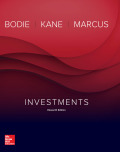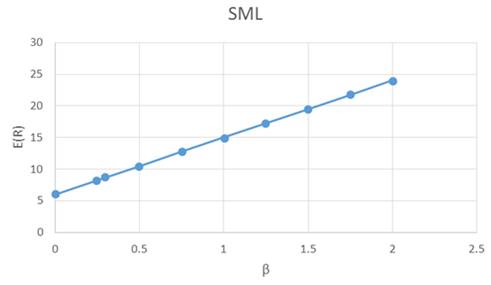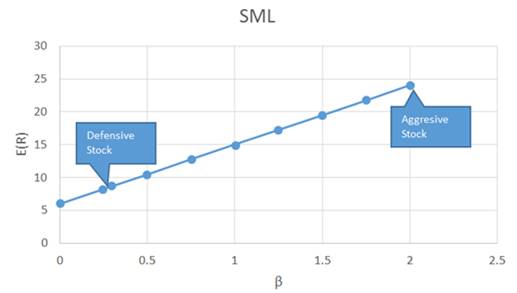
a.
To determine: The betas for the stocks
Introduction: Systematic risk is also known as volatility or non- diversifiable risk. It is the risk that is assumed by everyone before investing in a market. This kind of risk is unpredictable.
a.
Answer
The beta value for aggressive and defensive stock is 2.00 and 0.30 respectively
Explanation of Solution
Given Information: Market return, aggressive stock and the defensive stock is given
Beta measures an investment’s volatility as it correlates to market volatility. When beta value more than 1, it means the investment has more systematic risk than the market. If beta less than 1, it means less systematic risk. When beta equals to 0, the investment has same systematic risk as the market.
So, the beta value is 2.00 and 0.30 for aggressive and defensive stock respectively.
b.
To determine: The expected
Introduction: Systematic risk is also known as volatility or non- diversifiable risk. It is the risk that is assumed by everyone before investing in a market. This kind of risk is unpredictable.
b.
Answer
The expected rate of return for aggressive stock and for the defensive stock is 18% and 9% respectively.
Explanation of Solution
Given Information: Market return, aggressive stock and the defensive stock is given
The
Calculation of expected rate of return (Aggressive Stock),
By substituting the value of 2% and 38%,
The expected rate of return (aggressive stock) is 18%
Calculation of expected rate of return (Defensive Stock),
The expected rate of return (Defensive stock) is 9%
c.
To determine: The SML for the economy
Introduction: Systematic risk is also known as volatility or non- diversifiable risk. It is the risk that is assumed by everyone before investing in a market. This kind of risk is unpredictable.
c.
Answer
The SML for the economy is shown in the graph
Explanation of Solution
Given Information: Market return, aggressive stock and the defensive stock is given
The capital asset pricing model describes the expected return on beta based security. This model is used for determine the expected return on asset, which is based on systematic risk.
The expected rate of return of each stock,
Now substituting the value of Expected rate of return on market,
So, SML is,
The SML with the market return in the graph is,

d.
To determine: The alphas of each stock
Introduction: Systematic risk is also known as volatility or non- diversifiable risk. It is the risk that is assumed by everyone before investing in a market. This kind of risk is unpredictable.
d.
Answer
The alpha of defensive stock is 8.7% and for the aggressive stock is (-6%)
Explanation of Solution
Given Information: Market return, aggressive stock and the defensive stock is given
The capital asset pricing model describes the expected return on beta based security. This model is used for determine the expected return on asset, which is based on systematic risk.
The stocks on SML graph,

Calculation of alpha value for defensive stock,
Calculation of alpha value for aggressive stock,
So, the value of alpha is (-6%) for aggressive stock
e.
To determine: The hurdle rate used by the management for a project
Introduction: Systematic risk is also known as volatility or non- diversifiable risk. It is the risk that is assumed by everyone before investing in a market. This kind of risk is unpredictable.
e.
Answer
8.7% is the hurdle rate for the project
Explanation of Solution
Given Information: Market return, aggressive stock and the defensive stock is given
The capital asset pricing model describes the expected return on beta based security. This model is used for determine the expected return on asset, which is based on systematic risk.The hurdle rate can be calculated by the beta value of the project. The hurdle rate is the expected rate of return for the defensive stock.
Calculate the discount rate for the project,
By substituting the value of expected rate of market and beta value,
So, the hurdle rate is 8.7%
Want to see more full solutions like this?
Chapter 9 Solutions
EBK INVESTMENTS
- Which of the following is the best definition of cash budget? Question 10 options: Costs that rise with increases in the level of investment in current assets. A forecast of cash receipts and disbursements for the next planning period. A secured short-term loan that involves either the assignment or factoring of the receivable. The time between sale of inventory and collection of the receivable. The time between receipt of inventory and payment for it.arrow_forwardShort-term financial decisions are typically defined to include cash inflows and outflows that occur within __ year(s) or less. Question 9 options: Four Two Three Five Onearrow_forwardA national firm has sales of $575,000 and cost of goods sold of $368,000. At the beginning of the year, the inventory was $42,000. At the end of the year, the inventory balance was $45,000. What is the inventory turnover rate? Question 8 options: 8.46 times 13.22 times 43.14 times 12.78 times 28.56 timesarrow_forward
- The formula (Cash cycle + accounts payable period) correctly defines the operating cycle. Question 7 options: False Truearrow_forwardAn accounts payable period decrease would increase the length of a firm's cash cycle. Consider each in isolation. Question 6 options: True Falsearrow_forwardWhich of the following issues is/are NOT considered a part of short-term finance? Question 5 options: The amount of credit that should be extended to customers The firm determining whether to issue commercial paper or obtain a bank loan The amount of the firms current income that should be paid out as dividends The amount the firm should borrow short-term A reasonable level of cash for the firm to maintainarrow_forward
- Liberal credit terms for customers is associated with a restrictive short-term financial policy. Question 3 options: True Falsearrow_forwardAn increase in fixed assets is a source of cash. Question 2 options: True Falsearrow_forwardIf the initial current ratio for a firm is greater than one, then using cash to purchase marketable securities will decrease net working capital. True or falsearrow_forward
- what is going to be the value of American put option that expires in one year modeled with a binomial tree of 3 months step with year to expiry? assume the underlying is oil future with RF of 5% and vol of oil is 30%. Strike is 70 and price is 60 of oil. 13.68 13.44 13.01arrow_forwardhello tutor need step by step approach.arrow_forwardNeed step by step approach hrlparrow_forward
 Intermediate Financial Management (MindTap Course...FinanceISBN:9781337395083Author:Eugene F. Brigham, Phillip R. DavesPublisher:Cengage Learning
Intermediate Financial Management (MindTap Course...FinanceISBN:9781337395083Author:Eugene F. Brigham, Phillip R. DavesPublisher:Cengage Learning
 EBK CONTEMPORARY FINANCIAL MANAGEMENTFinanceISBN:9781337514835Author:MOYERPublisher:CENGAGE LEARNING - CONSIGNMENT
EBK CONTEMPORARY FINANCIAL MANAGEMENTFinanceISBN:9781337514835Author:MOYERPublisher:CENGAGE LEARNING - CONSIGNMENT



